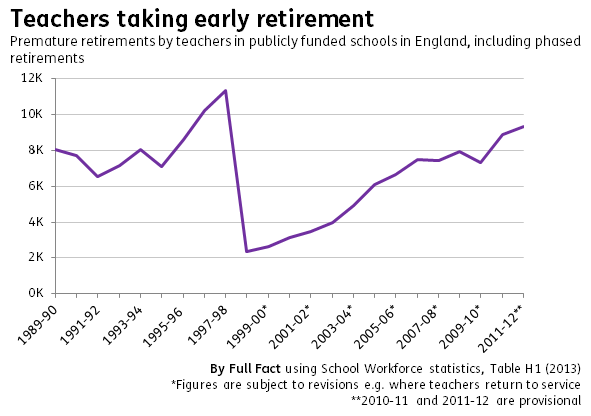Is a teacher shortage looming?
This article has been updated.
As public sector workers stage strikes across the UK today in a dispute around pay, pensions and conditions, the National Union of Teachers warned the government's policies are creating a looming teacher shortage.
There are more teachers than last year, and there are a record number. But there is evidence to suggest that increasing numbers are leaving the profession, and commentators have warned that there aren't yet enough entrants due to start on teacher training courses this September.
Numbers of teachers up 9,100
There has been an increase of 9,100 qualified teachers in the last year - up to a total of 451,100 teachers. This is the highest number recorded since 2000.
Even so, you can have increasing numbers of teachers and still have a teacher shortage if the number of pupils is rising faster.
But the number of teacher posts waiting to be filled remains low by historical standards, although it has increased slightly in the last year. There were 440 full time permanent teacher vacancies in November 2012, a rate of 0.1% of all teachers in post, which increased to 750 vacancies and a rate of 0.2% in 2013.
Thousands wanting to leave
The NUT said in their press release that thousands of teachers are leaving or considering leaving their job, which could put pressure on the numbers of teachers needed in the future to replace them.
Official statistics show an increasing number of teachers choosing to retire before they reach the official retirement age - although we only have statistics until 2011-12 until the latest set are published later this month.

The noticeable sharp decline after 1997 is just after changes to the Teachers' Pension Scheme which meant that many more teachers took early retirement in 1997 than previous years. Since 2007-08 teachers taking a phased retirement have been included, which could account for some of the increase in numbers from previous years - but we have no way of knowing how many people have been doing this from the figures.
But, we can't assume that all of these retirees lead to an immediate vacant teaching position. Some of these teachers will have left publicly funded schools already — for example to work in the private sector or in another job entirely — and so may have stopped teaching for many years before they claimed early retirement for their teachers' pension. This was the case for about a quarter of those claiming early retirement in 2011-12, whose last known job was in a different sector (including private schools).
We also don't know from these statistics how many teachers return to teaching after having retired — for example, they might return on a part-time basis.
So although these statistics show an increasing number of people retiring — it doesn't mean the same number of teachers are needed to replace them.
In terms of teachers wanting to leave, this is harder to measure and it's difficult to conclude how many dissatisfied teachers will leave. A ComRes survey conducted for NASUWT in December 2013 found around half (52%) of teachers had "seriously considered" leaving their job or the profession - based on the response of 501 teachers. This dissatisfaction was found to be mainly due to low salaries and excessive workload.
Shortage of trainees entering courses
Professor John Howson, a Research Fellow at the University of Oxford, has raised concerns that teacher training courses haven't yet reached the target number of entrants for the forthcoming academic year, which could lead to shortages further down the line.
The Department for Education estimates how many trainee teachers are needed to replace other teachers leaving the profession (for example, through retirement), and to account for any changes in pupil numbers. They assume a certain number of trainees won't complete their training and/or won't immediately start teaching in a state school.
Comparing these estimates for 2014/15 to the UCAS applications data for teacher training courses suggests that a number of subject areas may miss the required number of entrants - including biology, Design and Technology and Maths.
Professor Howson puts this down to the cyclical nature of teacher training - he told Full Fact that his research (£) had found more people choose to enter the profession during a period of recession (when they can't get other jobs), but when the graduate market improves, fewer people choose to become teachers.
Professor Howson said historically it has been easier to recruit primary teachers, when more used to do it as an undergraduate degree rather than the one year postgraduate course most people do now. But, the figures suggest there may be a shortage of entrants wanting to become primary school teachers too.
So far in England, 13,150 applications for primary teacher training courses have been accepted or offered a place - short of the total 20,595 required places. But, there are still another 7,700 'other' applications which includes where they've been declined, or where they could be waiting for a decision or for an interview, for example.
Although it's late in the applications cycle (university courses start in September/October), there's also still some time for teacher-hopefuls to apply so we'll have to wait until the autumn to find out whether the places have been filled.
One of our readers pointed out to us that some of the teachers taking early retirement may have stopped being in the teaching profession altogether - or in the public sector - previous to claiming retirement, and also some may return to teaching after claiming retirement. We have updated the piece to add in these points.

